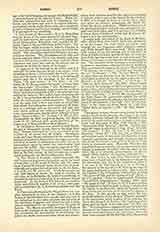

Lockhart, WILLIAM, son of the Rev. Alexander Lockhart of Waringham, Surrey; b. August 22, 1820; d. at St. Etheldreda’s Priory, Ely Place, Holborn, London, May 15, 1892. He was a cousin of J. G. Lock-hart, the well-known biographer of Sir Walter Scott. After studying first at Bedford Grammar School and, afterwards under various tutors, he entered Exeter College, Oxford, in 1838. He there made the acquaintance of Edward Douglas, afterwards head of the Redemptorists at Rome, Father Ignatius Grant, the well-known Jesuit, and John Ruskin. Like so many others whose early life has been passed in a purely Protestant atmosphere, Lockhart had hitherto taken it for granted that Protestantism represented the religion of the Apostles, and that to the title Christian Catholics could, properly speaking, lay no claim. The reading of Froude’s “Remains” and Faber’s “Foreign Churches” showed him how mistaken this opinion was. To set his doubts at rest, he visited Manning at Lavington, but felt so awed in the archdeacon’s presence that he did not dare to enter into a controversy. Subsequently, Manning urged Lockhart to accept Newman’s kind invitation to stay with him at Littlemore and prepare for (Anglican) ordination. After graduating Bachelor of Arts in 1842, he rejoined Newman at Littlemore, and was assigned the task of translating a portion of Fleury’s “History of the Church“, and of writing a life of St. Gilbert of Sempringham for the Oxford Series (see John Henry Newman). In this retirement his weakened faith in the Anglican Church was rudely shaken by the perusal of Milner’s “End of Religious Controversy” given him by Grant, who had become a Catholic in 1841. Lockhart now realized for the first time what Catholic doctrine was, and he saw all his doubts confirmed in the irresolution of Newman, at this time vainly seeking his Via Media between Catholicism and Anglicanism. After a few weeks’ hesitation, he declared to Newman that he could not go on for Anglican ordination doubting its validity as he did. Newman sent him to W. G. Ward, who persuaded him to return to Littlemore for three years.
About a year later, however, his meeting with Father Gentili of the newly-founded Order of Charity, at Ward’s rooms, brought matters to a crisis. In August, 1843, he visited Father Gentili at Loughborough, intending to stay only a few hours, but his visit resulted in a three days’ retreat and his reception into the Church. On August 29 he was received into the Rosminian Institute; he made his simple vows on April 7, 1844, and his solemn profession September 8, 1845. He was the first of the Tractarians to become a Catholic, and his conversion greatly affected Newman, who shortly afterwards preached at Littlemore his last sermon as an Anglican, “The Parting of Friends”. All communication between Lockhart and his mother ceased at first, by Manning’s orders, but mother and son were soon reconciled, and in July, 1846, Mrs. Lockhart followed her son into the Catholic Church. In November, 1844, he was included in the new community at Calvary House, Ratcliffe—the first Rosminian foundation in England. He was ordained subdeacon at Oscott on December 19, 1845, and deacon on June 5, 1846, and on December 19 of the same year was raised to the priesthood at Ratcliffe College. After some months devoted to the preaching of missions, Lockhart was entrusted with the pastoral charge of Shepshed, on June 5, 1847. He was still occasionally employed for mission work, and in 1850 was definitely appointed for this duty. After some years’ successful preaching in various parts of England and Ireland, he was compelled, owing to ill-health, to spend the winter of 1853 at Rome. On his return journey he paid a memorable visit to the celebrated Malian philosopher, Abbate Rosmini, at Stresa. In 1854 he was deputed to select a suitable place in London for the establishment of a house and church of his order. At the suggestion of Manning, he chose Kingsland, and until 1875 had to bear the burden of anxiety in connection with this foundation. In December, 1873, he purchased at his own expense St. Etheldreda’s out of Chancery, and thus restored one of London‘s oldest churches (thirteenth century) to Catholic worship. Removing to St. Etheldreda’s in 1879, when the work of repair was completed, he established himself there until his death, although he continued for many years to give missions and retreats. After 1881 he spent the winters in Rome as procurator general of the congregation, and was there frequently called upon to give a series of sermons in English. His death, of syncope, occurred very unexpectedly.
He was perhaps best known as the foremost English disciple of Rosmini, founder of the Institute of Charity. Several volumes of that philosopher’s works were translated either by him or under his supervision, and in 1886 he wrote the second volume of the “Life of Antonio Rosmini-Serbati”, of which the first volume had been written by G. S. MacWalter in 1883. He was an able polemic and was closely connected with two well-known Catholic periodicals, “Catholic Opinion”, which he founded and conducted until it was merged in “The Tablet”, and “The Lamp”, to which he was for twenty years the principal contributor. Besides his numerous contributions to these papers he wrote: “The Old Religion” (2nd ed., London, 1870); “Review of Dr. Pusey’s Eirenicon” (2nd ed., London, 1866), reprinted from “The Weekly Register”; “Communion of Saints” (London, 1868); “Cardinal Newman. Reminiscences of fifty years since by one of his oldest living Disciples” (London, 1891). For some years before his death he had been engaged on a second volume to form a sequel to “The Old Religion“, the best-known of his polemical works.
THOMAS KENNEDY

